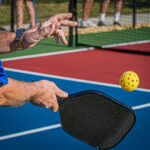Don’t Get Yourself in a Pickle
 Over the last several years the sport of pickleball has gained popularity. As a matter of fact, according to the Association of Pickleball Professionals, the sport is the fastest growing in the nation for the fifth consecutive year with nearly 49 million adults having played at least one game in the last 12 months.
Over the last several years the sport of pickleball has gained popularity. As a matter of fact, according to the Association of Pickleball Professionals, the sport is the fastest growing in the nation for the fifth consecutive year with nearly 49 million adults having played at least one game in the last 12 months.
Pickleball is booming because it’s easy to learn, inexpensive, and a fun social activity. But while pickleball is for the most part a low impact activity, doctors want participants to know about the common injuries associated with the sport and the simple steps to follow before hitting the court.
Common Pickleball Injuries
Tendonitis: Because of the repetitive motions used in the sport of pickleball, overuse injuries such as tendonitis are very common. This injury is the inflammation of the cords that attach the muscle to the bone and can occur with any tendon, but is most common in the elbows, wrists, shoulders, and knees.
Strains: Pickleball players are more at risk for muscle strains due to the variety of movements associated with the sport including bending, pivoting, twisting, turning and tethering. Muscle strains happen when the muscle is overstretched resulting in minor tearing of the muscle fibers. Strains can be mild or very serious.
Tennis (or pickleball) Elbow: Lateral epicondylitis, also known as tennis elbow, is one of the most common overuse injuries in pickleball due to the repetitive hitting motion. Tennis elbow is a tendonitis caused by repetitive wrist extension resulting in aggravation of the tendon on the lateral side of the elbow.
Sprains or fractures: The turning and pivot movements in pickleball can also cause falls resulting in sprained, or worse, fractures. A sprain happens when the ligaments that support a joint get stretched or torn, whereas a fracture occurs when the bones break.
Pickleball Injury Prevention
Stretching: As with any sport or physical activity you should stretch prior to participating. Stretching loosens and prepares your muscles and joints, increases flexibility, and decreases the chances of injury.
Proper shoes: Proper tennis shoes are important to offload your joints from the repetitive impact associated with the sport. You need a pair of shoes with support and adequate cushioning.
Practice proper techniques: There are certain strokes in pickleball such as dinking, volleying and the groundstroke. Take a few lessons prior to starting your league to ensure you learn the right form and practice your strokes even after you complete your lessons.
Know your personal limits: Another reason why pickleball is becoming so popular is because it appeals to all ages. Be aware of your physical limitations as they relate to the sport. If you are playing more for the social aspect, don’t play against teams that are more competitive, instead find a league that suits your level.
Pickleball is a great activity and I encourage everyone to try it. Just be careful so you don’t get in a pickle with your bones and joints and end up on the sidelines.


